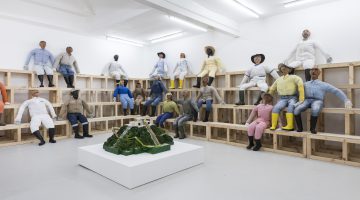Patrick Caulfield and Gary Hume are brought together in two exhibitions displayed back to back in separate galleries at the Tate Britain on London’s Embankment running until 1st September. This relatively bizarre duo seem to have no direct correlation with each other, apart form their love of using bold striking imagery and colour. The show is not advertised as a joint event, but as the running times are exactly the same and the gallery divided into two where normally one whole exhibit is in place, one can’t help but view them with reference to one another and the gap in-between the times of the artworks’ creation, 1963 to 2013, which adds very interesting dimensions of pushing and pulling of the past and present throughout both exhibitions.
The first exhibition I enter is Patrick Caulfield’s, though the shows are not designed to be viewed in any particular order I chose chronological. From the off the works are rich in colour and intrigue with Caulfield’s anonymous paint technique leaving no bush marks and no classic signs of the artist’s hand at work. Throughout the five rooms there is a gentle evolution. Outstanding in the first room is his absolutely stunning picture postcard painting ‘Santa Margherita Ligure’, 1964, and a painting of the famous cubist painter ‘Portrait of Juan Gris’ 1963, one of the artist’s early works, intriguing for its predominate figure, as he produced few figurative paintings; advancing to the fifth room where light and shadows are being used in Caulfield classic twee interior scenes to understand the depth of pictorial space. This five-room ‘retrospective’ is a perfect amalgamation of Caulfield’s work and though relatively small is bursting at the seams with depth and satisfaction.
Gary Hume’s exhibition is in a difficult position following the Caulfield show, and as I walk up to his first piece, being the entrance to the exhibition itself, a pair of bright pink doors harking back to his famous ‘Door Paintings’ which launched his career in the early 1990’s, I feel the transition maybe slightly unnatural. The works on display are mainly executed in his comfort style of household gloss paint on aluminium sheets. Hume’s show is questioning beauty and shining a light on the darker side of humanity in a playful and humours way, as in ‘Beautiful’, 2002, a circular aluminium canvas where Michael Jackson’s nostrils have been placed onto Kate Moss’s faintly sketched face. It goes further in later works with ‘Angela Merkel’, 2011, an abstract painting of the German Chancellor at the height of the Euro crisis, where Hume is address his ‘fascination with how individuals can reveal their vulnerabilities’. Hume’s work demands a lot of time and attention as the works have very subtle markings which, at a glance, can easily be missed, however even if only glancing, much like Caulfield, the basic colour composition and aesthetics are so automatically right.
With all my hesitations and doubt as to whether this pairing would work in this space I am very pleasantly and happily surprised. They work not only because of their use of bold colour, subtle details and questions about reality, but because the viewer can see an example of the slow yet ever-changing evolution of painting over the last 50 years. The shows do not act as competitors but are complementary where the viewer can get lost walking back and forth between these exhibitions endlessly finding something new or thinking something fresh.
For more information visit here.
-Contributed by Robert Strang






